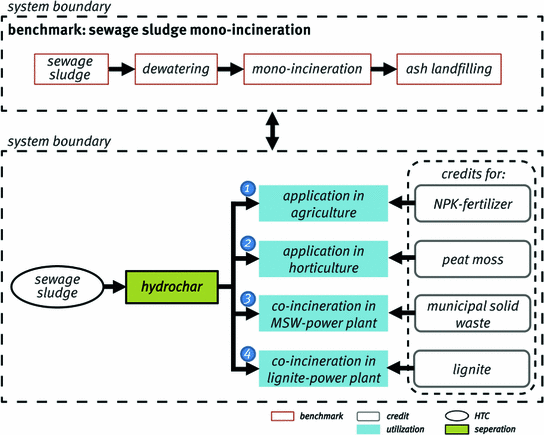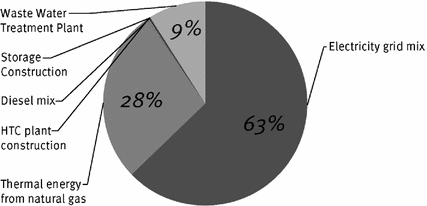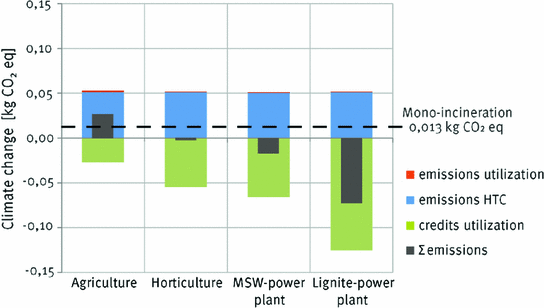1 Introduction
The growing demand for fertilizers due to a growing world population increases the pressure on limited natural nutrient resources. In particular, the supply routes of phosphorus, a non-renewable resource that could be depleted in 50 to 100 years, need to be reconsidered (Cordell et al. 2009; Sartorius et al. 2011). Recycling of materials with high phosphorus content must therefore be improved in order to secure the livelihoods of future generations. Sewage sludge is an important natural and locally available phosphorus source (Cordell and White 2011; Schoumans et al. 2015; Klinglmair et al. 2015). Existing treatment methods such as co-combustion in the cement industry or co-incineration in lignite-fired power plants reduce the P concentration in the ash and thus make phosphorus extraction more difficult and expensive. An ideal technology should offer maximum P-recovery rates, removal and destruction of potentially hazardous substances such as heavy metals, organic micropollutants and pathogens, good fertilising properties of the product, a good profitability and low environmental risks. (Egle et al. 2016; Leinweber et al. 2018). Therefore the Hydrothermal Carbonization (HTC) of sewage sludge is investigated as a promising approach for implementing a circular economy for nutrients (Brookman et al. 2016; Heilmann et al. 2014; Zhao et al. 2017) and a sustainable energy generation (Stucki et al. 2015; Libra et al. 2011; Titirici et al. 2007) with simultaneous decrease of pathogens and other organic pollutants (Vom Eyser et al. 2015, 2016; Weiner et al. 2013). HTC is a thermochemical process in aqueous phase under saturated pressure and temperatures between 160 and 250 ℃. Typically, over several hours biomass is converted into a valuable solid coal (hydrochar), partially dissolved fractions in the aqueous phase and a small amount of gases (usually CO2) (Berge et al. 2011; Bergius 1932; Kruse et al. 2013; Funke and Ziegler 2010). In recent years, there has been a growing interest in industrial applications of HTC as a waste treatment method and in the usability of the produced hydrochar (Hoekman et al. 2013; Buttmann 2011; Stucki et al. 2015). To evaluate the sustainability of this new approach, life cycle assessment (LCA) studies of HTC of different biomass feedstocks were performed (Owsianiak et al. 2016; Benavente et al. 2017; Liu et al. 2017; Stucki et al. 2015; Berge et al. 2015). In this study, an LCA of HTC of sewage sludge digestate and four different hydrochar applications were carried out an the results were compared to the usual process chain of sewage sludge mono-incineration with subsequent ash landfilling. The main goal was to identify the best utilization for hydrochar from sewage sludge characterised by the lowest CO2 footprint in comparison to the benchmark process of mono-incineration.
2 Methods
2.1 Material and Energy Flows
Model parameters for sewage sludge and carbonization conditions
Parameter | Unit | Value |
|---|---|---|
Sewage Sludge | ||
Dry matter (DM) | (%) | 5 |
Organic dry matter (DM) | (% of DM) | 48 |
Specific heat capacity | (kJ kg−1 K−1) | 4.58 |
Sludge input temperature | (℃) | 38 |
Hydrothermal Carbonization | ||
Carbonization temperature | (℃) | 220 |
Duration | (h) | 4 |
Hydrothermal Carbonization Parameters:
Material flows:
Energy flows:
2.2 Life Cycle Assessment
The LCA was conducted in accordance with the requirements of the ISO standard 14044:2006 (DIN EN ISO 14044 2006).
Functional Unit:
System Boundaries:

Different ulitizations scenarios of hydrochar with system boundaries of process chains and benchmark scenario
Geographic scope:
Modeling Framework:
LCA-software:
Life Cycle Inventory (LCI) data:
Life Cycle Impact Assessment (LCIA):
Assumptions and limitations:
3 Results and Discussion
Benchmark Process:
Emissions associated with HTC:

Distribution of GHG emissions for HTC process

Greenhousegas emissions of examined scenarios
Hydrochar utilization scenarios:
4 Conclusion
The LCA results of HTC of sewage sludge showed that substituting fossil based fuel (lignite and parts of MSW) with hydrochar had the highest potential to reduce global warming potential (GWP) of sewage sludge treatment. In comparison to the benchmark process of mono-incineration, it is even possible to achieve negative emissions. In general, the use of hydrochar for energy purposes had a higher GHG saving potential than their use in agriculture or horticulture. An improvement in the process design of sludge treatment with HTC would be the implementation of phosphorus extraction, which could enable phosphorus recycling even in the case of energetic use of hydrochar and therefore be helpful to boost the hydrothermal carbonization of sewage sludge. However, HTC process optimization should also take other LCIA categories into account. In addition, improvements in LCIA methodology are needed in order to evaluate benefits of the sludge treatment process, such as pathogen reduction and recycling of organic matter and nutrients back to agricultural or horticultural soil. Overall, the results show that there is a more sustainable alternative to the mono-incineration of sewage sludge.
Acknowledgements
This publication is a result of a project funded with federal state resources from the “Niedersächsisches Vorab”.